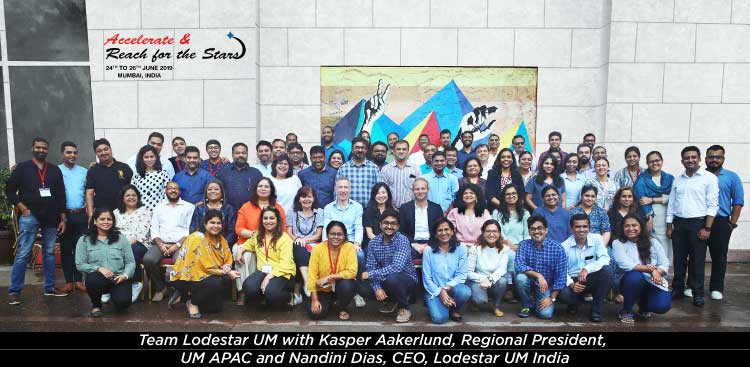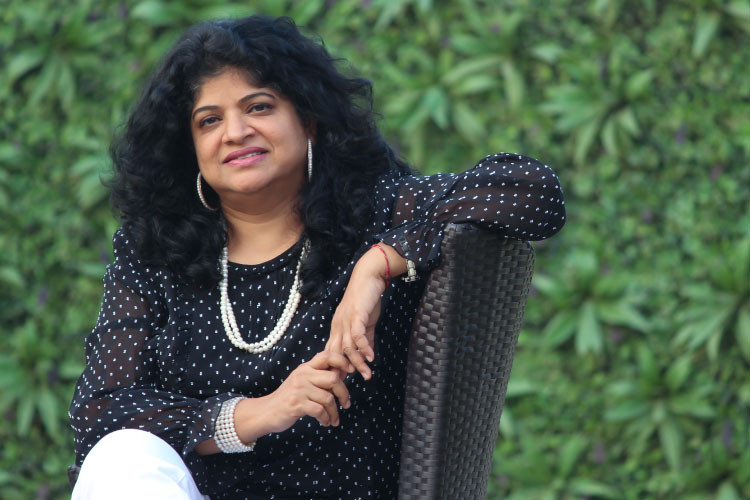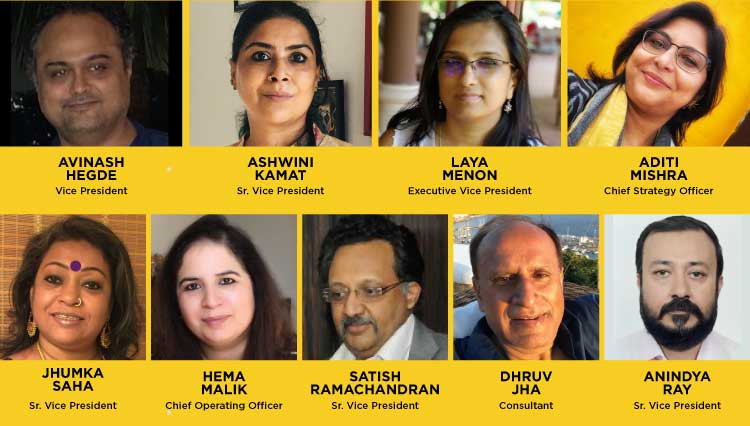It’s been five tumultuous months since the COVID-19 pandemic struck, a phenomenon that has changed the course of businesses, lives and entire sectors. Speaking of the profound impact the outbreak has had on the media landscape, Nandini Dias, CEO of Lodestar UM India is emphatic that this is the time for the agency to make flexibility, adaptability and speed its new mantra.
A torch-bearer for the media agency business, Dias talks at length about the need to stay focused on the various things agencies must do to gear up for the new normal. While discussing the challenges in ensuring efficiency in work-from-home mode, Dias tells us how the company has made the well-being of its employees a priority and also makes an impassioned plea for the ‘Live to Work to Live’ campaign that she spearheads.
Q] How has it been working from home? Tell us about your virtual experience of dealing with clients and colleagues over the past few months…
In terms of work, everything is efficiently progressing; admittedly, there is a depressed need. Humans are adaptive, and most people have comfortably settled into a rhythm. But it is a little strange, to be honest. There was a part of our regular job functions that never required direct human interaction and a part that did.
Currently, we can do the former, but as for the latter, even though we’re doing our best to make it work, the truth is, it does lack a certain undefinable visceral charge.
This is particularly in group interactions, where thoughts are built upon layer by layer with chatter, interruptions, talking over each other, and drawing from physical body language, which simply cannot be replicated online, where group discussions have to roll out sequentially rather than organically.
It gets tougher if it’s a person or a group that one hasn’t met before, like in a new business pitch. It becomes much more challenging to share the kind of chemistry or build relationships that are natural in normal life. Just a simple, thoughtful pause by one person in the room while the others are talking, for instance, says so much… but it’s not possible online in a group call at all.
Most meetings are driven by precise, task-oriented lists or agendas. What makes it even trickier is to interpret cultural nuances like the stereotypical Indian trait of people saying yes, even when they mean no. At a cerebral level, one can’t say it doesn’t work, but that raw human equation is missing or at least limited.
Perhaps that’s the reason why despite the best music technology and broadcast models, the feeling of being at a live music show or a live sporting event can never really be replicated.
Earlier, one imagined it to be short term, but now we need to consider some permanent changes. Starting with leadership tone and manner, method of sharing common values, managing data confidentiality, work protocols, empowering workforces, many aspects need to be tweaked and adjusted and altered for the new operating order.
Q] How do you assess the last one year at Lodestar India from a business viewpoint – until the industry’s equilibrium was hit by COVID-19 in mid-March?
We won some great new businesses like Zomato, Spotify, Amex, Mattel, Emirates, etc. We retained both Mahindra and Samsung. We got on board some great new talent too.
The new strategic lines that we had drawn up, both for ourselves and our clients, was what we were most excited and enthusiastic about. Lodestar UM was all geared and battle-ready for what was threatening to be a tough year, economy-wise. Let’s not forget that recessionary times were looming even before COVID-19.
The economy, both in India and globally, was undergoing severe turbulence. Still, Lodestar had realigned its strategy and reloaded its armory to navigate what we thought would have been a successful course ahead. Of course, COVID-19 resolved what was looking like a proper economic downturn by presenting us with a far graver situation.
The recession that stares at us now is not just economical, but social, emotional, political and moral as well.
Q] Other than the logistics, what were some of the things that you immediately did to take on the situation?
In all advertising and media agencies, people are the most valuable asset. We did take as many steps as were humanly possible to keep people safe and connected.
We’re still tweaking and adding to it as we speak. To ensure the health and well-being of people, we tied up with Doctor 24x7, which connects us with many big-city doctors and experts anytime, anywhere, and Mindhouse for physical fitness workouts from home, besides a renowned psychologist and behavioral trainer, personal counselor for emotional fitness.
To keep the larger team connected beyond the immediate tasks, we have created happy hours of interaction, games, live music concerts, caring and sharing. Besides, now we have business-wise new protocols of interaction with teams, clients and partners. That is settling in well.
FAST-FORWARD TO DIGITAL TRANSFORMATION
Nandini Dias, CEO, Lodestar UM India spoke with Nawal Ahuja, Co-founder, exchange4media earlier this month, about the role of technology in media. Dias says that it hasn’t been all doom and gloom for the industry, adding that the changing ecosystem also saw an acceleration of technological innovations. Here are excerpts from the discussion, which focused on how media agencies can better leverage technology and data to bring growth back.
On transformation of media agencies to communication agencies and why they have an edge
Dias pointed out that media agencies have been morphing for the last five years considerably. “We have expanded our scope. We do not confine ourselves to only media strategy and buying. The consumer journey or path to purchase has changed. It has shifted from being linear to a far more circuitous, winding journey. The new norm has created multiple revenue streams. We manage mass media campaigns - one to many - and we manage personalization - one to one. We guide e-commerce strategies of clients, we forge partnerships, we build analytical models. We have expertise in performance-led advertising, managing e-events.
Mediabrands has its own DMP. Within Mediabrands, we have specialists trained on Martech tools like Salesforce, Adobe. We have created experience centers for clients. We create content. Within content, we look into celebrity and influencer marketing. Our consultancy practice is steadily increasing. Media agencies are uniquely placed, as they understand brand, media, technology, research, data analytics. Most others can have limited experience.
For example, big consultancy companies have no real market and media experience. And often, the solution is not rooted in reality. Lodestar UM has often been the preferred partner when innovative or lateral solutions are expected,” Dias explained.
Leading with digital transformation
“COVID-19 has fast-tracked digital transformation by at least 2-3 years. So while digital transformation means different things to different people, for us, it has been across three main aspects. 1. Automation of processes, tools, data stacks, digitization of our call center basically digital initiatives, which translates to increased speed and agility, and operational efficiencies. 2. Merging technology with strategy, ie, personalization, precision targeting, performance advertising, etc., basically enhancing customer experience 3. Upskilling all in new Adtech and Martech tools,” Dias said.
The pandemic and the resultant lockdown saw Digital eat into a larger share of the advertising pie, and at a quick rate. Dias observed, “Digital transformation was already happening, though COVID has just made it leap forward. It is not just about COVID – the path to purchase and the consumer journey has changed.
It is no longer the linear journey that we used to see in the past. So, if the path to purchase is no longer linear but now more multidimensional then in a way, each category will behave differently and their needs will be different.” She added that the transformation will take place faster now, on account of the COVID situation that has seen a notable change in consumer behaviour. The game-changer for Digital will, however, be 5G, she notes, which will result in a huge jump for digital advertising.
It will also be interesting to note how brands and consumers leverage data in the coming months, added Dias. “Every day is a new day and different media channels will move up and down in terms of consumption. I think the interesting conversation on data is about what agencies and clients are doing with it.
The more programmatic we go, the more the platform becomes irrelevant because then it is only for the person who is in the market. It will then be about their intent, interest, and the cohort that I need to reach and it doesn’t matter whether I reach it through Facebook or a programmatic platform.
It will be interesting to see how clients are looking at consumers and how the whole Ad-tech/Mar-tech story is playing out,” said Dias.
Q] Lodestar UM’s study Wave X has directions for brands to take in COVID-19 times by latching on to the true cultural insight. Can you share some examples of how you have used this to your advantage?
Both, globally and locally, we invest disproportionately in capturing and mapping trends and developing software-based proprietary tools that ensure precise category based solutions to enhance productivity. Wave X is in its tenth year. And the year on year movement can be mapped by research and the tool.
The overwhelming direction this year was the Remix Culture. Remix Culture allows advertisers to understand cultural trends, territories in which brands should engage, audiences across the world, and the platforms they interact with. Using this data framework, we help marketers make their brands culturally relevant both today and in the future.
Besides Wave X, we are the only agency to invest in a proprietary single-source study named Moments that makes it possible to link an individual’s purchasing behaviour to specific media exposure. Nielsen conducts the research for us. It’s important to note that there is no guesswork or assumptions, no fusion or hybrid statistics. Moments is the only real single-source data that exists today.
Q] Tell us how Team Lodestar is poised right now… who are the people you would like to call out in the top leadership?
We have a superbly bonded team with the right attitude and a can-do mindset. It also helps that most of the team know each other for a really long time and genuinely believe that we are all in it together. More importantly, the team is not just formal colleagues but friends who like to bond well beyond working hours too.
Better still, these thought leaders and business drivers are spread across our offices. Aditi Mishra is the CSO and drives our strategic product - relentlessly challenging, anticipating, and aligning the company to new norms.
Hema Malik heads our Delhi Office, Laya Menon heads our Bangalore office. Anindya Ray not only heads our Kolkata office but directly drives some prestigious businesses for us.
The Mumbai office is large enough for us to have created mini Mumbai offices, some of which are bigger than some competitive agency offices. Jhumka Saha, Avinash Hegde, Ritu Trivedi, and Bhavesh Shah have been the core team, and to keep upping the game, we’ve just got some great new talent like Ashwini Kamat and Priyanka Randhawa on board.
And of course, we have Snigdha Chakrabarty, who pilots Data and Analytics and Dhruv Jha, who heads Content and Experiences. As I said, it’s a strong team, and I am proud of every member of it.
Q] As we see in your team, the gender balance is actually skewed towards women! What do you say to that?
It’s not something I thought about at all. Not when it was changing, and not now either. I just lock onto the highest professional competence and internal fit and leave it at that. It’s only much later when the dust settles that one realizes when it’s pointed out that the gender balance is female-skewed.
I do not think it is fair to defer to any one gender just like it is not appropriate to discriminate against anyone. Both are equally wrong biases to my mind. If by following a strict professional code, this is where we’ve netted out, I guess we’ve largely made the right calls. I’m a staunch believer in professional competence and respectful of moral and human ethics.
Other than that, I don’t worry too much about the chromosomes behind them.
Q] Overall, what are the talking points at Lodestar UM just now? What is being discussed most?
What I love is the never-ending air of excitement and expectancy about what we’re going to do next, among all our people. It’s an extremely healthy group trait, and even those who join in anew soon catch the adrenaline and go with the flow.
If there’s one thing that Lodestar can never be, it’s cynical. Right through the organisation and especially at senior levels, there is a healthy disrespect for cynicism in any form.
There’s also a healthy and enthusiastic attitude towards the new. A new strategy, a new technology, a new format, a new costing possibility, a creative media strategy which is the reason we do well in the award functions.
These days, for instance, what’s being hotly debated is, do we need to create desire to restart sales/push strategy or target people based on intent and pull and let the economy restart on its own. Besides that, enhancing the e-commerce strategy, data mining for better and new insights, tracking the mind and mood of consumers across different categories, etc.
Q] The strategy approach by Lodestar was the moot point of our conversation the last time we spoke – so what next in terms of strategy for the new normal?
Firstly, I think we have to get a fix on exactly where the battle lines are drawn. Once the turbulence calms down and the world and India defines what can and can’t be done, at least in the short-medium turn, that will give us a fix on the change in media consumption habits.
Actually, from a purely academic perspective, it’s a fascinating petri dish of changing consumer behaviour and media habits. What would typically evolve slowly over the years, perhaps even generations, has suddenly changed several times, and will turn a few times more, in a few months. Of course, one cannot overlook the profound moral, social and human trauma that continues to unfold around us, but for all the compassion we can summon up, one also needs to learn from mistakes of the past for what awaits us in future.
What will we as a race, feel, and do? What will it draw out from us as a market? Will we come back fighting… clawing and snarling to our capitalistic best, or worst, as some would like to think? Will we be more aware and cognisant and respectful of the planet that has nurtured and tolerated all of our ambitious civilizations to a point where they’ve begun to threaten our own existence? We need to look within ourselves and outside us for answers that will change how we think and work.
For Lodestar, much of what we have come to know as professional capabilities will have to be unlearnt. New learnings will have to be adopted. And adapted. New questions will have to be asked if we want new answers.
The media landscape has always been a reflection of what the marketplace truly desires. Those desires are changing fast and vastly. We will have to change equally fast.
I believe that for Lodestar, flexibility, adaptability and speed at which we display them will be the new mantras.
And as always, being Lodestar, we’re looking forward to it. Needless to say that we are focussed on data-driven marketing, context and content-driven optimisation, e-commerce strategies optimised for brand building and retail excellence… basically gearing up for the new normal.
Q] How do you assess the impact of the pandemic on advertising spends as well as consumer buying behaviour once the lockdown is lifted?
I do not think a single moment or incident in time has affected so much of humanity across so many fronts with such far-reaching consequences in the entire history of humankind. The ice-age perhaps, but nothing else comes to mind. Not even the wars.
But, the optimist in me hopes that by the festive season, the recovery will have started. And if India behaves more like China, there could be a quick resurgence. But with both demand and supply being impaired, it’s hard to deny that there will be a ripple effect in the short term. This is further compounded by the cash crunch, trade issues, and currency fluctuations all overlaid by the pandemic.
A lot will depend on how, as an industry, we stimulate demand, build desire, and create consumer confidence to spark a business revival. The key is to understand that perhaps it is time for a push strategy and not pull. If we focus on just ‘pull’, it will be more than 12 months before the economy revives.
Q] COVID-19 has sort of fast-forwarded the digital transformation of India. What are your observations in this regard? Do you see marketers spending more
on Digital going forward?
Digital transformation will manifest itself in many forms. Process, data, governance and automation will get a big boost. With more employees working from home, hardware (laptops /desktops), and software (firewalls, gateways, VPN devices) will see immediate requirements.
Most offices were not built for this scenario. In the last four months, we have created a completely new one view cadence, automated many aspects, hosted through a single window - IQ Metric Studio.
Within the media business, through the years we have been predicting that a large percentage of our lives will become digital. The collective digital network of communication has forced newspapers/ channels to reconsider new business models for news production, distribution, and consumption. Given the changes that are staring at us, there is no way that money will not follow behavioural shifts.
Q] You have made a fresh plea for flexi-timing to aid social distancing through the ‘WorkToLiveToWork’ campaign once offices reopen. How do you plan to
drive wider adoption of that?
Yes, I have. It’s not rocket science. It is logic and common sense. With our population density, it is not humanly possible to maintain ideal social distancing in the physical/geographical sense. The only way left is to keep it in chronological units. We should aim for social distancing through hours and minutes rather than meters and feet.
It’s a classic time and space choice. Just like in some countries, they can afford to use space to fight the time crunch; we can use time to fight the space crunch.
While I have been pushing it for some time now, FlexiTime is an idea whose time has come.
For a workforce that has learnt to operate for months without meeting or going to an office, it has become even more straightforward and logical to spread out our reporting times. FlexiTime will ensure that we can save the mindless loss of lives due to something as archaic and ridiculous as a late mark on an attendance register.
It never solved anything. And now it doesn’t even make sense. Grocery shops, medical stores, and essential supply establishments have done it efficiently during the lockdown by simply giving pre-decided timings for deliveries, pick-ups and shopping, and it finally settled down to work very smoothly. It’s high time offices did the same.
Maintain social distance through timing, not space, because we do not have space. It will help save lives and save your workforce.
Q] Have you experimented on any front in this lockdown period, just following your mind… not necessarily something to do with work?
I’ve started reading a lot more. I could be imagining it, but I feel my attention span and concentration when it comes to reading has expanded just a wee bit in these last few months. We’ve been playing quiz games and card games at home and it’s been years since the family has had time of any sort, so that’s been real good fun.
Also, while playing we take turns on whose music playlist will be on. So I am discovering new music. And like everyone else, watching far more movies and serials than ever.
Q] What will it take for the media and advertising industry to come back to normal? What are the top three suggestions you would like to make for the industry to help itself?
Media and entertainment will get back to normal only if the economy gets back to normal. From the various news items, it seems that the India lockdown has been the severest and so the measures that we may need are likely to be even more accentuated than some of the other markets.
I am no expert on this subject, and like most, I too have been reading suggestions from global and local economists what it will take for revival. My limited hope is that –
1. We go back to full manufacturing, the supply chain is enabled, and labour crisis is fixed 2. We uplift the current sentiment, build confidence, and create desire. 3. Since we work across categories we know that different sectors are facing diverse issues. Some tailor-made solutions by the Government may help. Needless to say, to jumpstart, the Government needs to aid the liquidity crunch and cash flows.























